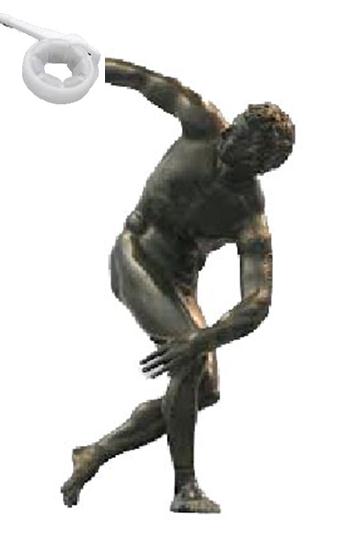6 Myths About the Adjustable Gastric Band

TIME TO THROW OUT SOME OLD MYTHS
It’s time to throw out some old myths about the adjustable gastric band, but before we start flinging those myths around, let’s all agree on what a myth is.
The traditional definition is that a myth is an ancient story of unverifiable, supposedly historical events. A myth expresses the world view of a people or explains a practice, belief, or natural phenomenon. For example, the Greek god Zeus had powers over lightning and storms, and could make a storm to show his anger.
If you think myths are dry stuff found only in schoolbooks, think again. They surround just about every aspect of our lives, and travel much faster now, in the age of technology, than they did in the dusty old days of ancient Greece and Rome. They’re a way for us to make sense of a chaotic world, both past, present and future. They affect thoughts, beliefs, emotions and assumptions in our everyday lives, coming alive in our minds as we, and the people around us, seem to act them out.
Some myths are helpful because they give us a shared sense of security and express our fundamental values and beliefs, but some myths are just plain wrong and can be harmful to us and to others. A good example is the myth that having weight loss surgery is taking the easy way out. Every time I hear that one repeated, I want to laugh and scream at the same time. If you’re a post-op, you know why. Weight loss is hard no matter how you do it (surgery, diet pills, prayer, magic cleanses, and so on). On the other hand, WLS is supposed to be easy, compared to the dozens or hundreds of weight loss attempts in our past. Why on earth would I put myself through a major surgery if it wasn’t going to help me lose weight and keep it off?
Now that we’ve shared a little laugh (or scream) over a WLS myth we can all agree upon, let’s test out some band myths whose validity may not be as clear. This kind of examination can be uncomfortable, but believing in a falsehood is almost guaranteed to make your WLS journey bumpier than it needs to be.
Let’s start with the myths that are easiest to digest and end with the ones that can be tougher for a bandster to swallow.
#1 – THE BAND IS THE LEAST INVASIVE WLS PROCEDURE
I believed this one at first, mainly because I knew little about the other WLS procedures back in 2007. It’s still a widely-circulated myth, one that even my surgeon’s well-intentioned dietitian endorses. So, what’s the truth according to Jean? Face it: any surgery done on an anesthetized patient, during which a surgeon cuts into the belly in several places, does some dissection (more cutting) and suturing (stitching) of the internal anatomy, and implants a medical device (the dreaded “foreign object”), is invasive. It is true that band placement generally involves less internal dissection and suturing than other weight loss surgeries, but neither is it on the same level medically as having your teeth cleaned. So while the invasiveness of a surgery is worth considering, you do yourself a disservice if you let that override other considerations. A bariatric surgery might last 45-60 minutes, with recovery lasting a week or so, but its effect on your health and lifestyle last a lifetime. Or I sure hope it does.
Some people associate invasiveness with irreversibility. Although the band is meant to stay put once clamped to your stomach, it can indeed be removed if medically necessary. Gastric bypass (RNY) surgery can also be reversed, while the sleeve (VSG) cannot and only the “switch” (malabsorptive feature) of the duodenal switch (DS) can be reversed. Removal or reversal is not as easy as operating on a “virgin belly” (as my surgeon so colorfully puts it), so it’s important to weigh the benefits against the risks of reversal or revision surgery.
#2 – BAND WEIGHT LOSS TAKES TOO MUCH WORK
Aside from the desire for instant and effortless weight loss (which is a fairy tale if I ever heard one) that so many obese people share (me among them), this is a myth that often turns people away from the band and towards other WLS procedures. While this myth may be true in the first 12-18 months after surgery, eventually everyone ends up in the same boat, rowing hard against the powerful tide of obesity.
Weight loss and weight maintenance is hard no matter how you achieve it. A dietitian who spoke at a band support group meeting I attended a few years ago said that while band patients must change their lifestyle immediately in order to succeed, every WLS patient must do that sooner or later. It’s a pay-me-now or pay-me-later deal. You can slice it, dice it, sauté it and serve it on your grandmother’s best china. However you serve it, weight loss and maintenance is a lifetime project because obesity is a chronic disease with no cure. No matter how successful we are as new post-ops, all of us must face the possibility of regain. That’s why I cringe when someone proudly crows, “XXX pounds gone forever!”
#3 – THE BAND’S SLOWER WEIGHT LOSS PREVENTS SAGGING SKIN
This is a fairy tale. According to several plastic surgeons I’ve heard speak on the subject. The effect of weight loss on skin depends mostly on your genetics and your age (because skin loses elasticity as we age). Other factors can be how obese you were, how long you were obese, how you carried your weight, and how much (and how) you exercise as you lose weight.
I’ve heard women say that they’d rather be obese than have sagging or excess skin. To my mind, that’s a sad statement, because I’d rather have sagging or excess skin (as long as it didn’t interfere with my ambulation or activities) than excess weight. Don’t get me wrong: I loathe the excess flab on my midsection (whose nickname is “The Danish Pastry”) and I’m not thrilled about my batwings, throat wattles, or anything else that’s happened to my skin in the past few years (during which I’ve undergone the double-whammy of weight loss and the fast approach of my 60’s). On the other hand, I think I look pretty good for a woman my age, especially when I conceal my figure flaws in flattering clothing which, I might add, no longer needs to be purchased at Lane Giant.
#4 – TO LOSE WEIGHT, YOU HAVE TO FIND YOUR SWEET SPOT
I used to wonder how the Sweet Spot Myth could survive in the face of so much clinical evidence against it, but last year I heard the “you gotta find your sweet spot” claim uttered by a bariatric dietitian, so apparently this is a myth being validated by medical professionals who ought to know better.
Instead of the sweet spot, Allergan (the first to introduce the band in the USA) uses a zone chart to illustrate band restriction, with not enough restriction in the yellow zone, good restriction in the green zone, and too much restriction in the red zone. In other words, restriction happens in a range of experience, not at a single static point. That experience changes over time as we lose weight, deal with ordinary processes such as hormonal fluctuations, hydration changes, stress, medications, time of day, and so on. It’s also affected by our food choices (solid vs soft/liquid food).
In my banded days, I traveled through and around a sweet spot many times. It might last for 30 minutes, 3 days, 3 weeks, but it never stayed exactly the same, and yet I still lost weight! I don’t actually want to stay exactly the same for the rest of my life (throat wattles notwithstanding). As any Parkinson’s disease patient will tell you (if they’re able to speak), a body that gets stuck in time is a very big problem (and with my luck, I’d get stuck in the worst sinus infection or case of the flu of my life). Some people who are very sensitive to their band and its fills find sudden or unexpected changes in restriction to be very, very frustrating, and I wouldn’t wish that on anyone, either.
To read more about the sweet spot, click here to go to an article, The Elusive Sweet Spot.
http://www.lapbandtalk.com/page/index.html/_/support/post-op-support/the-elusive-sweet-spot-r59
#5 – NO SIDE EFFECTS MEAN MY BAND ISN’T WORKING
Equating side effects with a properly working band is very common, and potentially very harmful. The two most significant signs of the band’s proper functioning are (1) early satiety and (2) prolonged satiety. Those signs are rarely expressed in large, bold, uppercase letters, such as
STOP EATING NOW!
Those signs won’t be accompanied by clanging bells or flashing lights, either. In fact, the less noise and distraction (such as “Why don’t I have stuck episodes?”), the more likely you are to be able to recognize early and prolonged satiety.
Before I tell you why the no side effects = broken band worry is a sign of mythical thinking, let’s make sure we agree on the definition of a side effect, and how that relates to complications. A side effect is an unintentional or unwanted effect of a medical treatment, and it’s usually exceeded (or at least balanced) by the benefits (the intentional, wanted effects) of that treatment. For example, antibiotics can cause diarrhea. That’s an unpleasant side effect, but an untreated infection can have far worse consequences for the patient. Side effects can often be managed by tweaking or changing the treatment, and they are rarely worse than the original condition.
A complication, on the other hand, is a more acute, serious consequence of a medical treatment, and usually needs a more aggressive approach, including surgery to fix the problem. Now let’s go back to the antibiotic example. An allergic, anaphylactic reaction to the antibiotic can be fatal without prompt medical treatment. That’s a complication, and it’s far worse than the original condition.
So in the context of all that, it seems strange to me when bandsters long for side effects like regurgitation (PB’s), stuck episodes, and sliming. Instead of looking for more subtle clues from their bodies (like early and prolonged satiety), they go looking for problems, and worse than that, they tend to “test” their band with foolish eating and/or overeating, hoping to provoke a side effect that will signal to them that they really do have a band in there. One of the many problems with that approach is that it can also provoke a complication. And that brings us to the final myth in today’s article:
#6 – THE MORE FILL, THE BETTER
I’ve heard bariatric surgeons comment that some band patients seem
to be addicted to fills. I can identify with that because I had a good relationship with my band surgeon who not only administered my fills but gave me a lot of encouragement as well as answers to my many questions. I left each fill appointment with a renewed sense of commitment and hope. How can you not get hooked on something good like that?
The problem with equating fills with weight loss success is that more fill is not always better. In fact, too much fill (which varies from one patient to the next, and also varies in a single patient as time goes on and the patient’s body keeps changing) can be downright dangerous. An overfilled band, and the side effects it causes (see #5 above), can lead to a complication like a band slip, esophageal dilation, or stomach dilation. While complications can come out of nowhere, most bariatric surgeons agree that too much saline in the band puts too much pressure on the stomach. Eventually something’s got to give. That’s often hastened by the patient’s efforts to eat around the problem, and it is absolutely not a guarantee of weight loss. I gained weight several times because of what’s called Soft Calorie Syndrome. My band was too tight and I was dealing with it by consuming mostly soft and liquid calories that offered little or no satiety.
The human body is an incredible organism, capable of amazing feats of growth and healing that we take mostly for granted, but it’s not endlessly forgiving. Too much fill in your band, too many eating problems, too much inflammation and irritation in the upper GI tract, can compromise your body’s ability to recover from a complication like a band slip. Sometimes a complication can be treated conservatively, with an unfill and rest period, but sometimes it requires a surgical fix, including removal of the band. And after all you’ve gone through to get that band wrapped around your stomach, shouldn’t you be doing your utmost to treat it (and your body) with respect?
Finally, the fill myth can cause us to overlook a very important guest at your WLS party….you. If you are going to succeed with your band, lose weight and keep it off and keep that band safe and sound inside you, sooner or later you will have to take personal responsibility for your success. Expecting your band alone to carry you to your goal weight is like expecting your car to safely deliver your child to school without anybody in the driver’s seat. And I sure hope that you are a very important person in your life!
I love love love this post. I will be among the blessed and banded in about 14 hours. This was such good info. Everybody that has, is getting, or cares about someone with or getting lapband needs to read this.
Excellent post!
I am sooo glad I read this post. I was one of those who thought , hmm why haven't I experienced this or that, though I feel I am good, still looking for something I didn't need to. Love it!! Eye opener indeed!
great article, Jean! thanks!
Thank you, this was some very valuable information !
I couldn't have said it better myself. Great article!
















☠carolinagirl☠ 18,721
Posted
wow, a definite eye opener I so hope everyone reads this post
Share this comment
Link to comment
Share on other sites